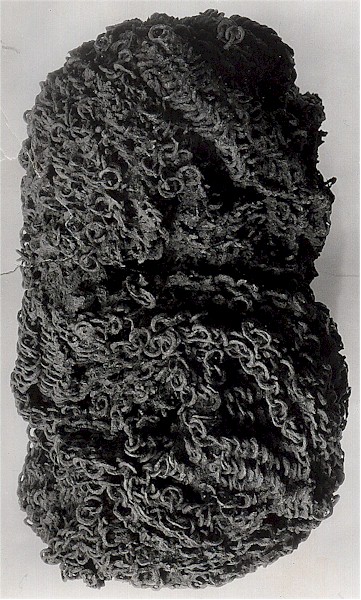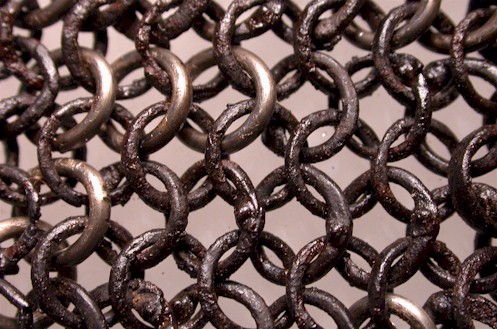| Author |
Message |
|
Stanley Hauser
|
 Posted: Tue 03 Dec, 2013 11:47 am Post subject: Authentic mail pictures Posted: Tue 03 Dec, 2013 11:47 am Post subject: Authentic mail pictures |
 |
|
Hi everyone,
I was wondering if someone could please provide me with pictures or links of actual historical mail? I'm trying to get a feel of what the variation of rings looked like, but I can't seem to find that many authentic pictures, much less a collection of pictures. I'm really looking for up-close images.
I know that Erik Schmid used to have a website up with lots of pictures as well. He seems to still be putting up his site...does anyone know where I can find some of those old pictures as well?
Thanks in advance, I'd appreciate any help you can give me.
|
|
   |
 |
|
Mart Shearer
|
|
  |
 |
Dan Howard

|
|
  |
 |
|
David Gaál
|
 Posted: Wed 04 Dec, 2013 11:41 am Post subject: Posted: Wed 04 Dec, 2013 11:41 am Post subject: |
 |
|
Wow, that must be realy heavy. The first looks interesting to me. Is there any detailed source about it?
Dávid
http://energie-fenster.at/
|
|
   |
 |
Dan Howard

|
|
  |
 |
|
Mart Shearer
|
 Posted: Wed 04 Dec, 2013 2:26 pm Post subject: Posted: Wed 04 Dec, 2013 2:26 pm Post subject: |
 |
|
Croom, A. T. 2001 A ring mail shirt from South Shields Roman Fort, Arbeia Journal, 6-7, 55-60
ferrum ferro acuitur et homo exacuit faciem amici sui
|
|
  |
 |
|
Stanley Hauser
|
 Posted: Wed 04 Dec, 2013 7:10 pm Post subject: Posted: Wed 04 Dec, 2013 7:10 pm Post subject: |
 |
|
Thank you guys, this helps a lot. I'm trying to compile everything I can.
I'm starting to understand, Dan, why you say that it is difficult to describe certain features of mail as "typical" when there is so much variation, even among the small amount of examples that we have.
|
|
   |
 |
Dan Howard

|
 Posted: Thu 05 Dec, 2013 5:35 am Post subject: Posted: Thu 05 Dec, 2013 5:35 am Post subject: |
 |
|
We have tons of examples. The problem is that most of them are collecting dust in reserve collections of various museums and have never been published.
Author: Bronze Age Military Equipment, Pen and Sword Books
|
|
  |
 |
|
Robert Rootslane
Location: Estonia Joined: 06 Aug 2007
Posts: 72
|
 Posted: Thu 05 Dec, 2013 12:47 pm Post subject: Posted: Thu 05 Dec, 2013 12:47 pm Post subject: |
 |
|
What has been done to it? Or was it so when they found it? All mail fragments i have seen so far, have been, well, flexible.
|
|
  |
 |
Dan Howard

|
 Posted: Thu 05 Dec, 2013 1:06 pm Post subject: Posted: Thu 05 Dec, 2013 1:06 pm Post subject: |
 |
|
Most in-situ photos of mail that I've seen consist of a solid concreted mass - just like the photo that Mart showed. It requires a lot of careful work afterwards to clean it up. In many situations the mail is too far gone to even make the attempt. All you can do is stabilize what is left and leave it in a solid mass. That's why it is a waste of time measuring the diameter and thickness of many extant examples of mail. Iron expands as it oxidises and then during the restoration process some of the material is subsequently removed. In a lot of cases it is impossible to know the original size and diameter of the links.
Author: Bronze Age Military Equipment, Pen and Sword Books
|
|
  |
 |
|
Mart Shearer
|
 Posted: Thu 05 Dec, 2013 2:59 pm Post subject: Posted: Thu 05 Dec, 2013 2:59 pm Post subject: |
 |
|
Absolutely. Here's a b&w photo of the Kungslena hauberk, probably from the late 12th or early 13th century.

X-ray analysis of excavated mail often shows a "shell" of iron oxide with no solid core to the rings, so it might be possible to get some measurements on the exposed rings, but no guarantee of the accuracy can be made. Any attempt to unroll or unfold the hauberk would likely turn it to dust and fused fragments.
The majority of mail coifs found at Wisby were described by Thordeman:
| Quote: | During the excavations we were very worried about the numerous mail coifs. They
were usually so very much destroyed by rust, that, when uncovered, they looked like a
layer of rust-coloured gravel, which disintegrated on being touched. In the cases
where there were the slightest prospects of preserving them, they were soaked on the spot
in paraffin wax and surrounded by gauze bandages, some of them in this way being salvaged
at the Museum's laboratory, while others could not be saved even by this method. |
ferrum ferro acuitur et homo exacuit faciem amici sui
|
|
  |
 |
|
Robert MacPherson
Industry Professional
Location: Jeffersonville USA Joined: 27 Feb 2008
Posts: 141
|
 Posted: Thu 05 Dec, 2013 4:56 pm Post subject: Posted: Thu 05 Dec, 2013 4:56 pm Post subject: |
 |
|
For a concreted mail object it should now be possible (if costly) to CT scan the thing and 3D print a copy. This would be like having your cake and eating it too. I understand that they are starting to do this to fossils.
Mac
Robert MacPherson
http://www.lightlink.com/armory/
http://billyandcharlie.com/
|
|
   |
 |
Eric S

|
 Posted: Thu 05 Dec, 2013 5:23 pm Post subject: Posted: Thu 05 Dec, 2013 5:23 pm Post subject: |
 |
|
Dan, one image that you posted a link to (http://www.roman-artifacts.com/Images/Chainmail1.JPG) says in its description | Quote: | | Iron mail or possible lorica hamata fragment. This fragment however has none of the known characteristics of Roman mail, which doesn't mean it can't be Roman, but rather that there's no reason to believe it is. The fragment does not appear to have any welded rings. The one that has a clear rivet hole in it is no different than the others where just the seam is visible, and the tiny size of the rivet makes recognizing them very difficult. No rivet heads are clear anywhere. And the fact is that Roman mail isn't alternating riveted/welded rings, it's riveted/solid punched rings. There are definitely no solid punched rings in the fragment. |
http://roman-artifacts.com/Armor%20Fragments%...agment.htm

|
|
   |
 |
Dan Howard

|
 Posted: Thu 05 Dec, 2013 5:33 pm Post subject: Posted: Thu 05 Dec, 2013 5:33 pm Post subject: |
 |
|
Thanks for the correction. I just did a quick google search for Roman mail. The text is misleading in saying that Roman mail used welded links but it shouldn't be all riveted like that one seems to be. When I get some time I'll post some more examples of real Roman mail.
Author: Bronze Age Military Equipment, Pen and Sword Books
|
|
  |
 |
Eric S

|
 Posted: Thu 05 Dec, 2013 6:32 pm Post subject: Posted: Thu 05 Dec, 2013 6:32 pm Post subject: |
 |
|
| Dan Howard wrote: | | The text is misleading in saying that Roman mail used welded links but it shouldn't be all riveted like that one seems to be. When I get some time I'll post some more examples of real Roman mail. |
I agree, they should not have worded it that way, I would like to see some real roman mail that is not concreted.
|
|
   |
 |
Dan Howard

|
 Posted: Thu 05 Dec, 2013 9:00 pm Post subject: Posted: Thu 05 Dec, 2013 9:00 pm Post subject: |
 |
|
| Robert MacPherson wrote: | | For a concreted mail object it should now be possible (if costly) to CT scan the thing and 3D print a copy. This would be like having your cake and eating it too. I understand that they are starting to do this to fossils. |
They are doing it with cuniform tablets too. When they run them through the 3d printer they increase the size by 2-3x to make them easier to read.
Author: Bronze Age Military Equipment, Pen and Sword Books
|
|
  |
 |
|
Erik D. Schmid
Location: St. Cloud, MN Joined: 21 Aug 2003
Posts: 80
|
 Posted: Fri 06 Dec, 2013 7:58 am Post subject: Posted: Fri 06 Dec, 2013 7:58 am Post subject: |
 |
|
Here is an image of Roman mail from the Carlingwark loch find in Scotland. If I recall correctly, the links have an inner diameter of around 5mm.
 Attachment: 73.81 KB Attachment: 73.81 KB

http://www.erikds.com
|
|
   |
 |
Benjamin H. Abbott

|
 Posted: Fri 06 Dec, 2013 10:23 am Post subject: Posted: Fri 06 Dec, 2013 10:23 am Post subject: |
 |
|
|
This site has a ton of pictures of Middle Eastern and South Asian mail, some of which are up close.
|
|
  |
 |
|
Stanley Hauser
|
 Posted: Fri 06 Dec, 2013 11:37 am Post subject: Posted: Fri 06 Dec, 2013 11:37 am Post subject: |
 |
|
| Benjamin H. Abbott wrote: | | This site has a ton of pictures of Middle Eastern and South Asian mail, some of which are up close. |
Awesome! Now only if they had a European mail gallery...
|
|
   |
 |
Eric S

|
 Posted: Fri 06 Dec, 2013 12:44 pm Post subject: Posted: Fri 06 Dec, 2013 12:44 pm Post subject: |
 |
|
| Stanley Hauser wrote: | | Benjamin H. Abbott wrote: | | This site has a ton of pictures of Middle Eastern and South Asian mail, some of which are up close. |
Awesome! Now only if they had a European mail gallery... |
Now that would be something, imagine all of the known European mail images collected and made available for viewing in one place, that would be a worth while effort.
http://www.pinterest.com/samuraiantiques/european-mail-armor/
Last edited by Eric S on Fri 06 Dec, 2013 5:55 pm; edited 1 time in total
|
|
   |
 |
|
|

